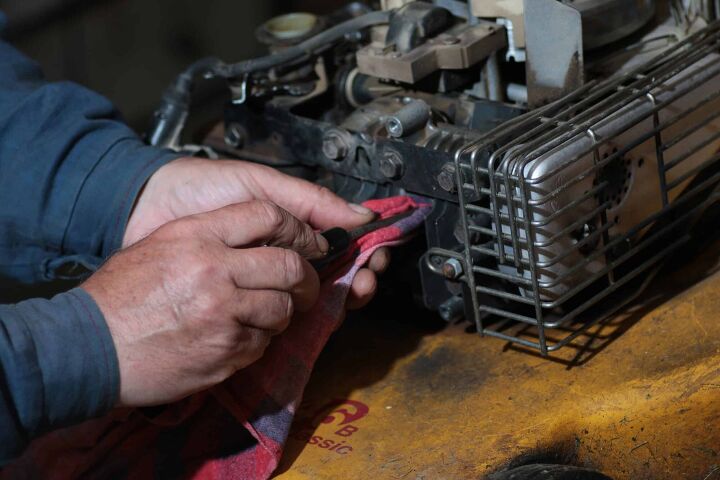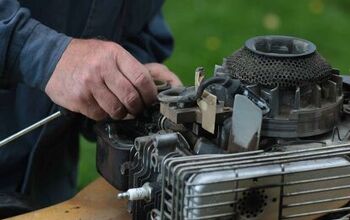How To Clean A Carburetor On A Push Lawnmower

Although a lawnmower is a crucial machine for lawn care and maintenance, many owners don’t take care of their mowers as well as they should. Over time, dirt, debris, and grass can get kicked into the motor, affecting various internal components. One of the most critical pieces is the carburetor (aka carb), which helps make the motor work. You should clean your carb at least once per season to keep it in good condition.
To clean a carburetor on a push mower, you’ll have to do a visual inspection to see how dirty it is, and whether the connections are sticky. We recommend using a carburetor cleaner so that you don’t have to pull the piece out of the motor. Spray the cleaner onto the part, let it sit for about 10-20 minutes, and wipe off any excess dirt and grime.
Because the carburetor is such a crucial part of your push lawnmower, you must take care of it. In addition to outlining these specific steps, we will illustrate how to tell when a carburetor needs cleaning and what it does for your mower.
Do You Need a Mower Repair Service?
Get free, zero-commitment quotes from pro contractors near you.

What You’ll Need to Clean Your Mower’s Carburetor
You shouldn’t have to pull the carburetor out of your mower to clean it in most cases. However, if it’s been sitting for years or it is really dirty, we recommend pulling the piece out so that you can get it back to like-new condition. Here are all of the tools necessary for both options.
- Carburetor cleaner
- Rag or towel
- Vice clamp
- Needlenose pliers
- Small bowl
- Socket wrench set
- Work gloves
Step by Step Guide to Cleaning a Push Mower’s Carburetor
Step One: Put the Push Mower on an Elevated Surface
Assuming that you don’t want to have to lay flat on the ground while working, it’s always better to raise the mower. If you have a work table or two benches, that should suffice. Make sure that the mower is stable and won’t roll off. In some cases, you may have to put blocks next to the wheels.
Step Two: Check the Air Filter
One primary reason for a dirty carb is the air filter. So, be sure to inspect and replace this piece as necessary. If there isn’t much dirt or debris in the filter, you can simply wipe it down with a damp rag to clean it.
Step Three: Inspect the Connections to the Carb
There are multiple pieces connected to the carburetor, so you will want to check these to ensure that they are not too sticky or dirty. Also, pay close attention to any of the screws or brackets holding the carb in place. The vibrations of the motor can sometimes knock these pieces loose.
Step Four: Spray the Carburetor With Cleaner
While you could use household detergent, carburetor cleaner is designed to eliminate the various fluids in your mower’s engine. Most other cleaners won’t do the trick, so you’ll have to make multiple passes. Instead, you can do one full coating with carb spray, and it should be good to go.
After about 10 or 20 minutes, wipe down the carburetor with your rag or towel. This will remove any dirt or grime. The carb doesn’t have to be spotless, but be sure to remove any substantial messes.
If you’re able to clean the carburetor with the spray, you don’t have to remove it. However, in extreme cases, we recommend pulling the piece off so that you can give it a good scrub.
How to Remove a Carburetor to Clean it
Step One: Clamp and Detach the Fuel Line
Gasoline goes into the carb through the fuel line, so you will have to clamp it so that it doesn’t make a mess. Use a vice grip to do this. Some gas is already inside the component, so place a towel underneath the connector to catch spillage. You can also use a small bowl to see if the gasoline is corroded or dirty.
Next, pinch the spring clamp and slide it back. This clamp holds the fuel line in place, so you should be able to pull it off with it removed. Gas will likely dribble out once you do this.
Step Two: Unlink the Throttle Cable
There is a wire cable that connects to the carburetor to control the throttle. You can disconnect this with a set of needlenose pliers. Be careful not to damage this component, as it is sensitive.
Step Three: Detach the Carburetor
Using a socket wrench, you can loosen the bolts that are holding the carb in place. Once you do that, the piece should pull out relatively easily.
Step Four: Spray the Carburetor
Using the cleaning spray, cover the whole piece. However, don’t spray anything into the carb, as it will mix with the fuel and could cause problems. If necessary, plug any holes with either tape or a wadded up rag.
Step Five: Scrub the Carburetor
After letting the spray sit for about 10 minutes, you can take a toothbrush to scrub the carb’s smaller sections. Be sure to check for any rusted areas, as it could be a sign that you have to replace the whole unit.
Step Six: Replace the Carburetor
Once the carb is cleaned, you can reattach it by reversing these steps. Put the piece in place, screw in the bolts, reattach the throttle connector and reattach the fuel line.
Step Seven: Test the Motor
Whenever doing any kind of maintenance work on your lawnmower, it’s vital to test the machine afterward. This way, you can be sure that you put everything back correctly.
Tips and Tricks for Cleaning a Carburetor
Since this project is somewhat complicated, here are some ways to make it run a bit smoother.
- Read the Manual First – Most push lawnmower engines are similar, but some models may be configured differently. Before doing any work, be sure to familiarize yourself with the layout so that you don’t make any mistakes.
- Wear Gloves and Eye Protection – While it’s unlikely that anything will get into your eyes, safety should always be a priority. When wearing work gloves, keep in mind that you may have to take them off to reach into tighter spaces. However, they will keep your hands clean while you work.
- Inspect Other Parts of the Motor – If the carburetor is dirty, chances are that other components are as well. Take the time to inspect and clean the rest of the motor.
Dangers of a Dirty Carburetor
As we mentioned, the carb is an essential part of your lawnmower. If it gets too dirty, it can affect how well the machine runs. Here are some problems you may experience. These issues are a sure sign that your carburetor needs attention.
- Stalling and Sputtering – As dirt and debris get into the engine, they can clog the internal mechanisms, causing the mower to stop suddenly.
- Not Starting – If the carburetor isn’t working properly, it won’t allow the mower to start at all.
- Black Smoke – When dirt gets into the carb, it can burn off, creating black smoke. Usually, the air filter is to blame for this problem as well.
- Overheating – If your mower is getting much hotter than usual, the likely culprit is the carburetor. While multiple issues can cause overheating, a dirty component can be one of them.
Do You Need a Mower Repair Service?
Get free, zero-commitment quotes from pro contractors near you.

Related Questions
How often should I clean my carburetor?
Realistically, you should clean this piece at the end of each season, before putting the mower away for the winter. This way, you can be sure that your carb is in good condition next spring. Also, be sure to drain the fuel tank, as leftover gas in the carburetor can cause problems.
What does the carburetor do on my push mower?
This piece is a regulator, controlling how much air and gas go into the motor to cause combustion.

We are a team of passionate homeowners, home improvement pros, and DIY enthusiasts who enjoy sharing home improvement, housekeeping, decorating, and more with other homeowners! Whether you're looking for a step-by-step guide on fixing an appliance or the cost of installing a fence, we've here to help.
More by Upgraded Home Team










![Does Your Toro Recycler 22 Not Start? [Common Causes & Fixes]](https://cdn-fastly.upgradedhome.com/media/2023/07/31/9070987/does-your-toro-recycler-22-not-start-common-causes-fixes.jpg?size=350x220)

![10 Best Cordless Leaf Blowers – [2022 Reviews & Ultimate Guide]](https://cdn-fastly.upgradedhome.com/media/2023/07/31/9070789/10-best-cordless-leaf-blowers-2022-reviews-ultimate-guide.jpg?size=350x220)

![How Much Weight Can a 4×4 Support Horizontally? [It Depends!]](https://cdn-fastly.upgradedhome.com/media/2023/07/31/9070333/how-much-weight-can-a-44-support-horizontally-it-depends.jpg?size=350x220)











![Cost To Drill A Well [Pricing Per Foot & Cost By State]](https://cdn-fastly.upgradedhome.com/media/2023/07/31/9074980/cost-to-drill-a-well-pricing-per-foot-cost-by-state.jpg?size=350x220)
